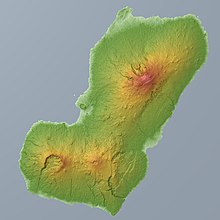Pennant colobus monkey
| Pennant colobus monkey | ||||||||||||
|---|---|---|---|---|---|---|---|---|---|---|---|---|

Pennant colobus monkey ( Piliocolobus pennantii ) |
||||||||||||
| Systematics | ||||||||||||
|
||||||||||||
| Scientific name | ||||||||||||
| Piliocolobus pennantii | ||||||||||||
| ( Waterhouse , 1838) |
The Pennant colobus monkey ( Piliocolobus pennantii ) is a primate from the group of colobus monkeys that is endemic to the equatorial Guinean island of Bioko and lives mainly in the southwest of the island.
features
Pennant colobus monkeys reach a head body length of about 63 centimeters, the tail is relatively long with 60 to 66 centimeters as with all colobus monkeys. The weight varies between 5.8 and 9 kilograms, with males becoming heavier than females. The Pennant colobus monkey is a relatively large species of the red colobus monkey, but its tail is relatively short. As with all colobus monkeys, the body is slim and the thumb is reduced. The color of the fur is variable, generally the top of the head and back is reddish-black or completely black, the sides of the body are strikingly red and the underside is light reddish-white or pure white. Hands and feet are black. The tail is black on top and dark red on the underside. The cheeks and whiskers are white. Conspicuous black hair swirls sit above the ears. The skull is narrow and the teeth are relatively small. The bare skin of the face is blackish.
Habitat and way of life
The Pennant colobus monkey occurs in lowland and mountain rainforests from sea level to altitudes of 1500, possibly also to altitudes of 1800 meters. Its area of distribution is characterized by an extremely humid climate. In the south of the island of Bioko, where most of the animals live, up to 10,000 liters of rain can fall on one square meter per year. Little is known about the way of life of the Pennant colobus monkey because the animals have never been scientifically investigated in the wild. As a result, these animals are diurnal tree dwellers that feed on leaves, flowers, buds, fruits and possibly also seeds. Like all colobus monkeys, they have a multi-chambered stomach . They live in groups of 5 to 30 animals, which are made up of one to three adult males, many females and their pups.
threat
The Pennant colobus monkey is an endangered species. The reasons for this lie in the progressive destruction of the habitat, and there is also hunting for their meat and fur. The IUCN lists the species as endangered .
Systematics
The Pennant colobus monkey was first scientifically described in 1838 by the British zoologist George Robert Waterhouse under the scientific name Colobus pennantii . Originally, the Bouvier colobus , which occurs in the Republic of the Congo in the region of Sangha and Likouala , and the Niger Delta colobus , which lives in the Niger Delta in Nigeria , were assigned as subspecies of the Pennant colobus monkey. However, both were given the rank of independent species in 2007 by the British-Australian mammalogen Colin Groves
literature
- Thomas Geissmann : Comparative Primatology. Springer-Verlag, Berlin et al. 2003, ISBN 3-540-43645-6 .
- Don E. Wilson, DeeAnn M. Reeder (Eds.): Mammal Species of the World. A taxonomic and geographic Reference. Johns Hopkins University Press, Baltimore MD 2005, ISBN 0-8018-8221-4 .
Individual evidence
- ↑ a b c d D. Zinner, GH Fickenscher & C. Roos: Family Cercopithecidae (Old World Monkeys) . Pp. 550-753 In: Russell A. Mittermeier, Anthony B. Rylands & Don E. Wilson (Eds.): Handbook of the Mammals of the World, Vol. 3. Primates, 2013, pp. 707-708.
- ↑ Procolobus pennantii in the endangered Red List species the IUCN 2006. Posted by: Oates, JF & Struhsaker, T., 2008. Accessed on March 18 of 2019.
- ^ Colin P. Groves: The taxonomic diversity of the Colobinae of Africa. Journal of Anthropological Sciences, Vol. 85 (2007), pp. 7-34, PDF
